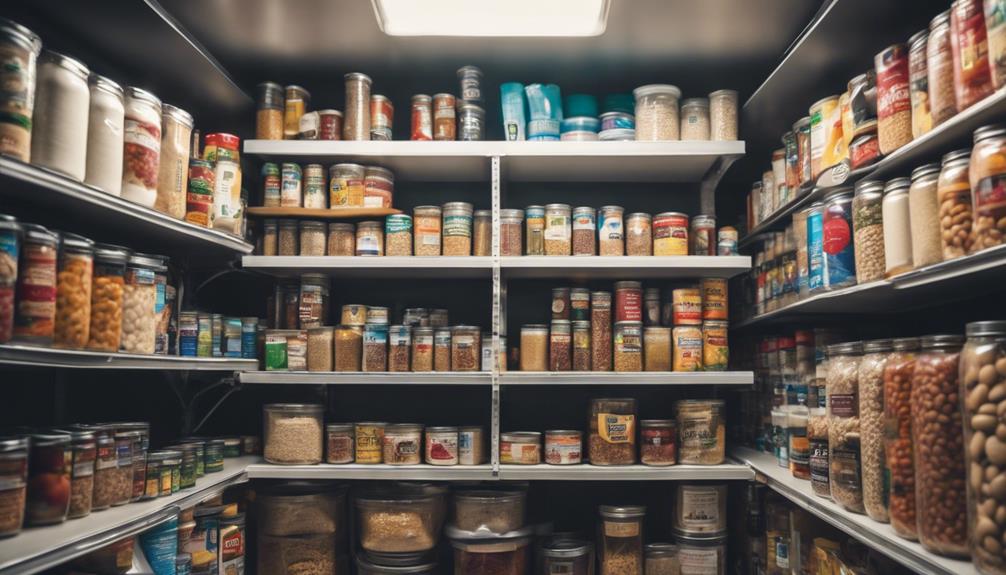To maintain seaweed quality, start by thoroughly drying it in a cool, dark place to prevent mold and nutrient loss. Using proper techniques like sun-drying or low-temperature dehydration helps preserve its flavor, texture, and nutrients. Once dried, store the seaweed in airtight, moisture-proof containers away from light and heat to slow spoilage. Combining good drying practices with proper storage guarantees freshness and quality over time—continue exploring to learn more ways to keep your seaweed at its best.
Key Takeaways
- Dry seaweed in a well-ventilated, low-humidity environment to prevent mold and preserve quality.
- Use clean, moisture-proof packaging, such as vacuum-sealed or nitrogen-flushed bags, to protect against moisture and oxygen.
- Store dried seaweed in cool, dark places to slow degradation and maintain flavor and nutrients.
- Avoid direct sunlight and temperature fluctuations that can cause spoilage or loss of quality.
- Incorporate fermentation techniques prior to drying for enhanced preservation and flavor development.

Have you ever wondered how to preserve seaweed effectively after harvest? Proper storage is essential to maintain its nutritional value, flavor, and overall quality. One of the most effective ways to do this is by employing fermentation techniques. Fermentation not only extends the shelf life but also enhances the digestibility and adds unique flavors to the seaweed. You can initiate fermentation by soaking the fresh seaweed in brine, which encourages beneficial microbial activity. This process helps break down complex compounds, making the seaweed easier to digest and preserving it naturally without relying heavily on preservatives. When done correctly, fermentation creates an environment that inhibits spoilage bacteria while promoting desirable microorganisms, ensuring your seaweed stays fresh longer. Using specialized fermentation containers can further optimize the process by providing a controlled environment for microbial activity and gas release.
In addition to fermentation, packaging innovations play a vital role in preserving seaweed quality during storage. Modern packaging materials are designed to prevent moisture loss, protect against oxygen exposure, and block light, all of which can degrade the product over time. Vacuum sealing is a popular option that removes air from packaging, reducing oxidation and microbial growth. Alternatively, nitrogen-flushed packaging can displace oxygen without compressing the seaweed, maintaining its texture and color. Some advanced packaging solutions incorporate moisture absorbers or oxygen scavengers to further extend shelf life. It’s important to choose packaging that suits your storage environment and intended duration of preservation. Properly sealed packages also make handling easier, reduce contamination risks, and improve transportation safety.
Furthermore, combining fermentation techniques with innovative packaging methods can greatly enhance preservation efficacy. For example, fermented seaweed stored in vacuum-sealed bags can have a longer shelf life with minimal quality loss. This combination leverages natural preservation methods alongside modern technology, providing a reliable way to keep seaweed fresh from harvest to consumption or sale. You should also consider storing your seaweed in cool, dark places, as temperature and light are key factors influencing spoilage. Consistent storage conditions help maintain the integrity of fermentation and prevent deterioration caused by humidity or temperature fluctuations.
Frequently Asked Questions
How Does Humidity Affect Seaweed Drying Efficiency?
Humidity considerably impacts seaweed drying efficiency. High humidity levels hinder moisture removal, slowing down the drying speed and risking spoilage. To improve drying, you need to focus on humidity control, ensuring the environment stays dry enough for quick, effective drying. Proper humidity management helps maintain seaweed quality, prevents mold growth, and speeds up the process, making your drying operation more efficient and reliable.
What Are the Best Storage Containers for Dried Seaweed?
You should store dried seaweed in airtight containers to keep moisture out and preserve freshness. These containers prevent humidity from compromising the quality over time. Additionally, consider using breathable packaging, like paper bags or woven baskets, for short-term storage or if you want some airflow. Proper storage in airtight containers or breathable packaging helps maintain flavor, texture, and nutritional value, ensuring your seaweed stays fresh for longer periods.
How Long Can Dried Seaweed Be Stored Without Quality Loss?
You can typically store dried seaweed for up to 1 year without significant quality loss if you use proper preservation methods. Studies show that, with airtight containers kept in a cool, dark place, shelf life extends and maintains flavor and nutrients. To maximize freshness, avoid humidity and light exposure. So, plan your storage carefully, and enjoy your seaweed at its best within this period.
Are There Specific Temperature Requirements for Seaweed Storage?
You should store dried seaweed at a temperature between 10-20°C to maintain quality. Proper temperature control helps prevent mold growth and nutrient loss. Keep moisture management in check by storing seaweed in airtight containers and in a cool, dry place. Avoid temperature fluctuations, as they can cause condensation and spoilage. Consistent, moderate temperatures guarantee your seaweed stays fresh, flavorful, and nutritious for longer periods.
How to Detect Spoilage During Seaweed Storage?
Oh, the thrill of spotting spoiled seaweed—what a delight! You should start with a visual inspection; if it’s slimy, discolored, or moldy, that’s your first clue. Then, give it a sniff—if it smells sour or off, you’ve got a problem. Spoiled seaweed doesn’t hide well, so trust your senses. Catch it early with these simple checks, and you’ll keep your seaweed fresh and tasty!
Conclusion
By properly drying and storing seaweed, you preserve its quality, enhance its flavor, and extend its shelf life. Through careful handling, consistent techniques, and mindful storage, you guarantee the seaweed remains fresh, nutritious, and valuable. By maintaining proper drying methods and choosing ideal storage conditions, you protect its texture, preserve its nutrients, and guarantee its usability. In doing so, you uphold the quality, maximize the benefits, and enjoy the full potential of your seaweed.









